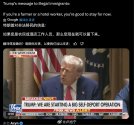I still think that the US and China will reach an agreement sooner or later, even if it is not a comprehensive agreement. This trade clash of such intensity is not beneficial to either party; no trade can survive a rate of 145%. But it seems that Beijing is better prepared. Since 2018, they have managed to gather a lot of ammunition to use. Even though China no longer has experts on the US as it did in the first trade war (Liu He), Li Qiang and Wang Wentao seem to be working well. But if the Chinese had started this work of expanding consumption back in 2015/2016, as I have already reiterated here, perhaps today they would have even more means to fight head-on.
I understand your concerns about the trade situation. If possible, I believe the Chinese government would also be willing to reach agreements with the U.S., even on terms that are relatively fair or require China to make minor concessions.
However, the core issue is this: America’s problems cannot be solved by China absorbing minor losses. Frankly, the U.S. system would require all nations globally to sacrifice themselves as blood supplies to sustain America’s survival for another 15-20 years. Even if "successful," this U.S.-built order would inevitably collapse.
China cannot sacrifice the wealth of its people – past, present, or future – to prop up a U.S. system with no hope of revival.
Ultimately, most countries worldwide will find it difficult to compromise with America. They will realize that the price the U.S. demands far exceeds their expectations – an unbearable cost.
Key Contextual References:
U.S. tariff coercion: The Trump administration’s 10% tariff hikes aim to extract $400 billion annually from global trade, reflecting systemic desperation.
China’s strategic restraint: Beijing’s countermeasures (e.g., targeted tariffs, export controls) prioritize stability while resisting U.S. demands for economic subjugation.
Global awakening: As noted in China Daily’s April 2025 editorial, nations increasingly recognize the unsustainability of U.S.-led extractive models.

